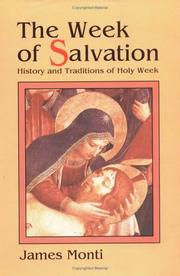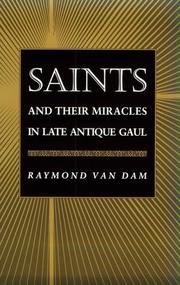| Listing 1 - 3 of 3 |
Sort by
|

ISBN: 0879735325 9780879735326 Year: 1993 Volume: 532 Publisher: Huntington: Our sunday visitor,
Abstract | Keywords | Export | Availability | Bookmark
 Loading...
Loading...Choose an application
- Reference Manager
- EndNote
- RefWorks (Direct export to RefWorks)
Investigates the liturgy, Scripture, and history behind the High Holy Days of Christendom and find out why Holy Week is vital to Christian devotion.
Book
ISBN: 9782701022680 2701022681 Year: 2018 Volume: 126 Publisher: Paris: Beauchesne,
Abstract | Keywords | Export | Availability | Bookmark
 Loading...
Loading...Choose an application
- Reference Manager
- EndNote
- RefWorks (Direct export to RefWorks)
L'orthopraxie catholique en matière de jeûne se fonde sur le respect de trois règles : un seul repas complet par vingt-quatre heures, auquel on a ajouté, à partir du XIIIe siècle, une légère collation vespérale ; l'abstinence des viandes et des laitages ; l'heure imposée pour l'unique réfection quotidienne, soit la mi-journée. Cadre disciplinaire général que nombre de théologiens se sont efforcés d'assouplir pour rendre les contraintes du Carême plus supportables. Dès lors s'est développée une ample casuistique dont les interrogations ont pu surprendre. S'il est vrai que les liquides ne rompent pas le jeûne, est-il permis en Carême de boire entre les repas du café, du chocolat, de la bière, de l'eau-de-vie, ou de manger de la pastèque ? Si les poissons sont incontestablement des aliments maigres, qu'en est-il des oiseaux aquatiques, des canards, des poules d'eau, des flamants, des crocodiles, des reptiles ou, au Brésil, du caïman yacare ? Entre les tenants de la rigueur et les partisans de l'indulgence, l'opposition a été telle que le magistère romain a dû réagir : entre 1741 et 1745, le pape Benoît XIV publie trois encycliques pour tenter de raffermir une discipline du Carême dont les observances tendaient à se relâcher. En dépit du geste pontifical, la pratique quadragésimale apparaît très fortement affaiblie à la mi-xixe siècle. Avec l'effacement du respect du précepte du jeûne ecclésiastique se donne à voir la sortie du catholicisme de l'ordre pénitentiel qui a longtemps été le sien.
248.153.4 --- 248.153.4 Vasten. Versterving. Onthouding --- Vasten. Versterving. Onthouding --- Fasting --- Jeûne --- Religious aspects --- Catholic Church --- Aspect religieux --- Eglise catholique --- Carême --- Lent --- Église catholique --- Doctrines. --- Catholic church --- Doctrines --- Jeûne --- Carême --- Église catholique

ISBN: 0691021120 0691032335 9786613891181 1400821142 1283578735 9780691032337 9780691021126 9781400821143 1400819318 9781400819317 9781283578738 Year: 1993 Publisher: Princeton, N.J. : Princeton University Press,
Abstract | Keywords | Export | Availability | Bookmark
 Loading...
Loading...Choose an application
- Reference Manager
- EndNote
- RefWorks (Direct export to RefWorks)
Saints' cults, with their focus on miraculous healings and pilgrimages, were not only a distinctive feature of Christian religion in fifth-and sixth-century Gaul but also a vital force in political and social life. Here Raymond Van Dam uses accounts of miracles performed by SS. Martin, Julian, and Hilary to provide a vivid and comprehensive depiction of some of the most influential saints' cults. Viewed within the context of ongoing tensions between paganism and Christianity and between Frankish kings and bishops, these cults tell much about the struggle for authority, the forming of communities, and the concept of sin and redemption in late Roman Gaul. Van Dam begins by describing the origins of the three cults, and discusses the career of Bishop Gregory of Tours, who benefited from the support of various patron saints and in turn promoted their cults. He then treats the political and religious dimensions of healing miracles--including their relation to Catholic theology and their use by bishops to challenge royal authority--and of pilgrimages to saints' shrines. The miracle stories, collected mainly by Gregory of Tours, appear in their first complete English translations.
Christian pilgrims and pilgrimages --- Christian saints --- Saints chrétiens --- History --- Cult --- Culte --- Histoire --- Gaul --- Gaule --- Religious life and customs --- Vie religieuse --- History. --- 235.3*23 --- Hagiografie: miracula --- 235.3*23 Hagiografie: miracula --- Saints chrétiens --- Pilgrims and pilgrimages, Christian --- Christian shrines --- Pilgrims and pilgrimages --- Saints --- Canonization --- Cult&delete& --- Christian saints - Cult - France - History --- Christian pilgrims and pilgrimages - France - Tours - History --- Martinus ep. Turonensis --- Hilarius ep. Pictaviensis --- Iulianus ep. Cenomannensis --- Gregorius ep. Turonensis --- Aeneid. --- Alternative medicine. --- Amulet. --- Archdeacon. --- Ariamir. --- Arianism. --- Augustine of Hippo. --- Austrasia. --- Baptism of the Lord. --- Brioude. --- Burgundians. --- Burial. --- Caesarius. --- Catholicism. --- Chararic (Frankish king). --- Chlothar I. --- Chlothar II. --- Christianity. --- Church Fathers. --- Clergy. --- Confidant. --- Consecration. --- Deference. --- Desiderius. --- Dysentery. --- Easter. --- Eternal life (Christianity). --- Exorcism. --- Falernian wine. --- Folk healer. --- Fredegund. --- Generosity. --- Georgius. --- God. --- Great martyr. --- Gregorius. --- Gregory of Tours. --- Hagiography. --- Helladius. --- Heresy. --- His Family. --- Historian. --- Humility. --- Intercession. --- Jews. --- Late Antiquity. --- Lent. --- Leprosy. --- Literary criticism. --- Literature. --- Magnus Maximus. --- Marmoutier. --- Martin of Tours. --- Martyr. --- Matricula. --- Merovech. --- Merovingian dynasty. --- Monastery. --- Old Testament. --- Paganism. --- Palladius of Saintes. --- Patron saint. --- Paulinus of Nola. --- Penitential. --- Persecution. --- Peter and Paul. --- Piety. --- Poitiers. --- Pope Gregory I. --- Potion. --- Predestination. --- Procession. --- Putrefaction. --- Radegund. --- Relic. --- Reliquary. --- Remigius. --- Resurrection of the dead. --- Righteousness. --- Rite. --- Roman Gaul. --- Saint. --- School of Graduate Studies (SPS). --- Secularism. --- Self-healing. --- Silvester. --- Slavery. --- Spirituality. --- Suffragan bishop. --- Sulpicius Severus. --- Theodosius I. --- Theology. --- Tomb. --- Tours. --- True Cross. --- Veneration. --- Visigoths. --- Weidemann. --- Word of Faith. --- Writing.
| Listing 1 - 3 of 3 |
Sort by
|

 Search
Search Feedback
Feedback About UniCat
About UniCat  Help
Help News
News